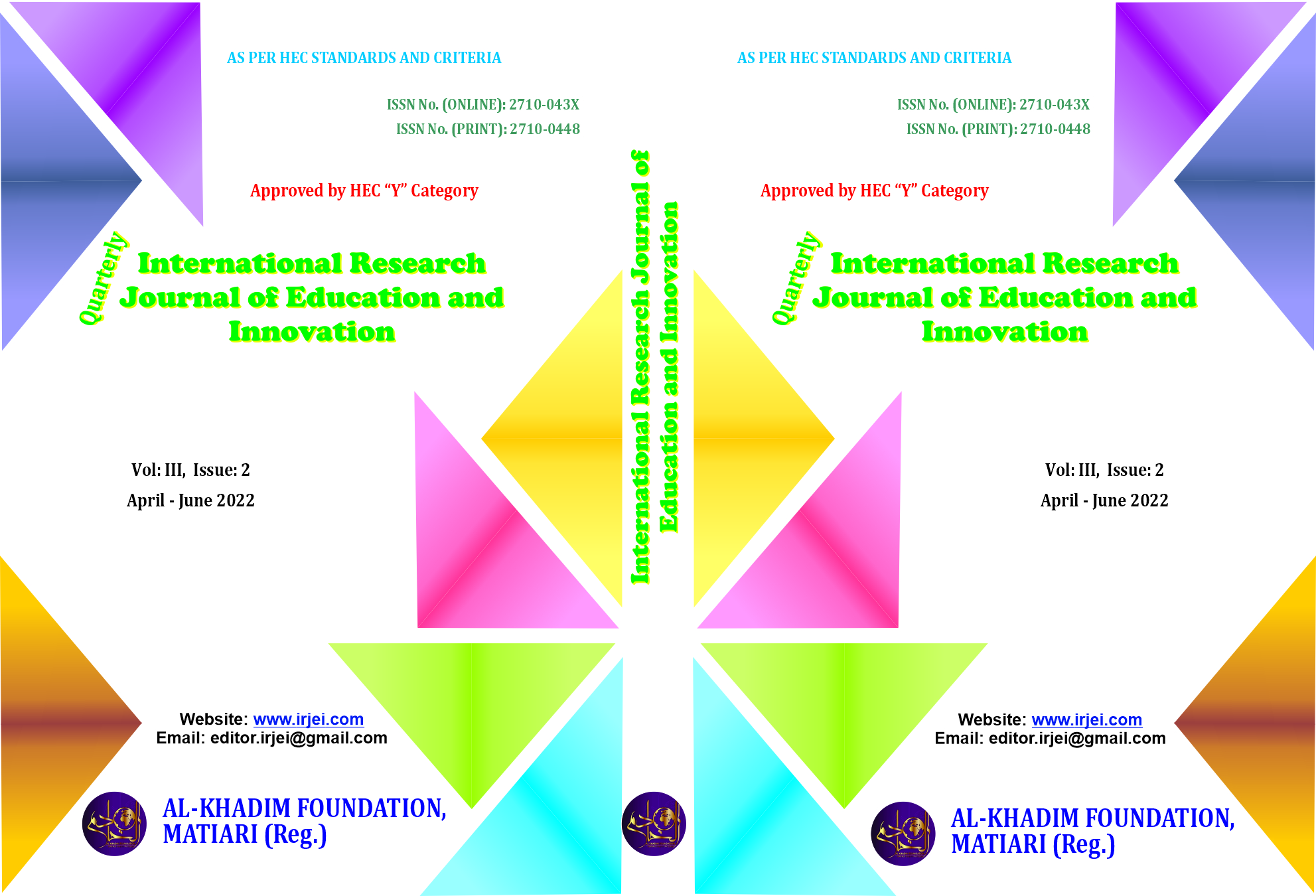Effect of Fine Motor Skill activities on Handwriting of Low Achiever Students and High Achiever Students at Elementary Level in Khyber Pakhtunkhwa, Pakistan
DOI:
https://doi.org/10.53575/irjei.v3.02(22)5.48-57Keywords:
Motor skill, hand writing, elementary level, effect, techniques, toolsAbstract
This study was carried out to find the Effect of fine motor skill activities on handwriting of low achiever students and high achiever students at elementary level in Khyber Pakhtunkhwa, Pakistan. In developing writing, the students are required to learn fine motor skills while working firsts in groups and then independently. With accurate fine motor skills, the students can increase their writing. That is why the researcher conducted this experimental study to get the hypotheses tested. For this purpose two teaching-learning techniques. Lecture demonstration method and teaching motor skill activities were used. Both the groups were treated to observe the desirable impact of fine motor skills on writing of Kindergarten class students. The sample for such study was taken from Girls Primary School Pabbi Nowshera. The subjects were divided into Control and Experimental groups on the basis of pre-test. Both the groups were given treatment to investigate: (i) Effects of fine motor skills on writing of low achievers students, (ii) Effect of fine motor skills on writing of high achievers students, (iii) to compare the effect of fine motor skills on writing of both low achievers and high achievers students. At the end of the treatment/interventions activity, a Post– Test was conducted to the sample. The numerical data thus collected was analyzed and interpreted by implying statistical tools.
References
Adams, M. (1990). Beginning to read: Thinking and learning about print. Cambridge, MA: MIT Press.
Alston, J., & Taylor, J. (1987). Handwriting: theory, research and practice: ERIC, 1987.
American College Testing (ACT). (2005). Crisis at the core: Preparing all kindergarten students for college and work. Iowa City, IA: Author.
Amundson, S.J., & Weil, M. (1992). Handwriting: Evaluation and intervention in school settings. In: Development of hand skills in the child. American Occupational Therapy Association, 1992.
Amundson, S. J., & Weil, M. (1996). Prewriting and handwriting skills. In: Occupational therapy for children. St. Louis: Mosby, 1996, pp 524–541.
Asher, A. (2006). Handwriting instruction in elementary schools. American Journal of Occupational Therapy, 60, 461-471.
Baydar, N., Brooke-Gunn, J., & Furstenberg, F. (1993). Early warning signs of functional literacy: Predictors in childhood and adolescence. Child Development, 64, 815-829.
Beery, K., & Beery, N. (2006). BeeryTM VMI: Administration, scoring and teaching manual (5th ed). Minneapolis, MN: NCS Pearson, Inc.
Benbow, M., Hanft, B., & Marsh, D. (1992). Lesson 5 Handwriting in the classroom: Improving written communication. In C. Royeen (Ed.), AOTA self-study series: Classroom applications for school-based practice. Rockville, MD: American Occupational Therapy Association.
Bergmann, K. (1990). Incidence of atypical pencil grasps among nondys functional adults. American Journal of Occupational Therapy, 44, 736-740.
Berninger, V. (1994). Future directions for research on writing disabilities: Integrating endogenous and exogenous variables. In G. R. Lyon (Ed.), Frames of reference for the assessment of learning disabilities: New views on measurement (pp. 419-439). Baltimore: Paul H. Brookes.
Berninger, V. W., Judith, E.R. , Robert, D.A. and Noelia, G. (2006). Tier 1 and Tier 2 early intervention for handwriting and composing. Journal of school Psychology, 44(1), 3-30.
Berninger, V., & Rutberg, J. (1992). Relationship of finger function to beginning writing: Application to diagnosis of writing disabilities. Developmental Medicine and Child Neurology, 34, 155-172.
Cahill, S.M (2009). Where does handwriting fit in? Strategies to support academic achievement. Intervention Sch Clin, 2009, 44: 223–228.
Cantu, C. O. (2004). Toy Alternatives: Crafts and fine motor development. The Exceptional Parent, 34(10), 28-29.
Copple, C., & Brendekamp, S. (Eds.). (2009). developmentally appropriate practice in early childhood programs (3rd ed). Washington, DC: National Association for the Education of Young Children.
Desai, A.S., & Rege, P.V. (2005). Correlation between developmental test of Visual Motor Integration (VMI) and handwriting in cerebral palsy children. Indian J Occup Ther, 2005, 37: 27–31.
Donoghue, M.R. (1985). The child and the English language arts. 1985.
Exner, C.E. (1992). In-hand manipulation skills. In: Development of hand skills in the child. American Occupational Therapy Association, 1992.
Henderson, A., & Pehoski, C. (2006). Hand function in the child: Foundations for remediation. Elsevier Health Sciences.
Irwana, L. M. & Jannah, M. (2018). Relationship of finger function to beginning writing: Application to diagnosis of writing disabilities. Developmental Medicine and Child Neurology, 34, 155-172.
Jones, C., Reutzel, D., & Fargo, J.D. (2010). Comparing two methods of writing instruction: effects on kindergarten students’ reading skills. Journal of Educational Research, 103(5), 327-341.doi: 10.1080/00220670903383119
Lamme, L.L (1979). Handwriting: In an early childhood curriculum. Young Child, 1979, 35: 20–27.
Laszlo, J.I., & Bairstow, P.J. (1984). Handwriting: difficulties and possible solutions. Sch Psychol, 1984, 5: 207–213.
Morin, A. (2017). Handwriting involves more than just making letters on a page it requires strong fine motor and visual-motor skills. 6 fine motor skills activities for kids. “The Everything Parent’s Guide to Special Education.”
National Educational Psychological Service (2015). Strategies to Develop Fine Motor Skills Recommendations for Early Primary School Children NEPS, Report Writing Group, 2015. Fine Motor-Strategies-Early Years. Retrieved on June 19, 2022 from https://assets.gov.ie/ 41278/ 3fd0d14bc5 dd4a98be14bbcb59c90de1.pdf
Poole, C., Miller, S. A., & Church, E. B. (2005). Development: Ages & stages--Emerging physical skills. Early Childhood Today, 19(7), 22-25.
Schneck, C., Amundson, S. & Case-Smith, J. (2010). Prewriting and handwriting skills. In: Occupational therapy for children, 6th ed. St. Louis: Mosby, 2010, pp 555-580.
Stewart, R.A., Rule, A.C, & Giordano, D.A. (2007). The Effect of Fine Motor Skill Activities on Kindergarten Student Attention. Early Childhood Education Journal 35(2):103-109.
Suzanne, T. (2005). Scissors: More than a cut above. School Arts, 104(5), 42-43.





